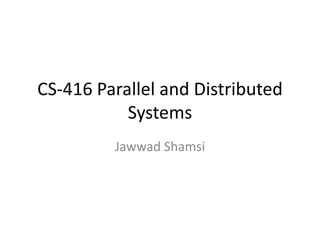Lecture1
•Transferir como PPTX, PDF•
1 gostou•749 visualizações
Denunciar
Compartilhar
Denunciar
Compartilhar

Recomendados
Recomendados
Mais conteúdo relacionado
Mais procurados
Mais procurados (20)
Coherence and consistency models in multiprocessor architecture

Coherence and consistency models in multiprocessor architecture
Destaque
Destaque (7)
Parallel and Distributed Algorithms for Large Text Datasets Analysis

Parallel and Distributed Algorithms for Large Text Datasets Analysis
Advanced full text searching techniques using Lucene

Advanced full text searching techniques using Lucene
Semelhante a Lecture1
UNIT 1 CLOUD COMPUTINGUnderlying principles of parallel and distributed computing

Underlying principles of parallel and distributed computingGOVERNMENT COLLEGE OF ENGINEERING,TIRUNELVELI
Semelhante a Lecture1 (20)
Underlying principles of parallel and distributed computing

Underlying principles of parallel and distributed computing
Último
Último (20)
Choosing the Right FDO Deployment Model for Your Application _ Geoffrey at In...

Choosing the Right FDO Deployment Model for Your Application _ Geoffrey at In...
Behind the Scenes From the Manager's Chair: Decoding the Secrets of Successfu...

Behind the Scenes From the Manager's Chair: Decoding the Secrets of Successfu...
Introduction to FDO and How It works Applications _ Richard at FIDO Alliance.pdf

Introduction to FDO and How It works Applications _ Richard at FIDO Alliance.pdf
Salesforce Adoption – Metrics, Methods, and Motivation, Antone Kom

Salesforce Adoption – Metrics, Methods, and Motivation, Antone Kom
Where to Learn More About FDO _ Richard at FIDO Alliance.pdf

Where to Learn More About FDO _ Richard at FIDO Alliance.pdf
The Value of Certifying Products for FDO _ Paul at FIDO Alliance.pdf

The Value of Certifying Products for FDO _ Paul at FIDO Alliance.pdf
What's New in Teams Calling, Meetings and Devices April 2024

What's New in Teams Calling, Meetings and Devices April 2024
Extensible Python: Robustness through Addition - PyCon 2024

Extensible Python: Robustness through Addition - PyCon 2024
Intro in Product Management - Коротко про професію продакт менеджера

Intro in Product Management - Коротко про професію продакт менеджера
How Red Hat Uses FDO in Device Lifecycle _ Costin and Vitaliy at Red Hat.pdf

How Red Hat Uses FDO in Device Lifecycle _ Costin and Vitaliy at Red Hat.pdf
Measures in SQL (a talk at SF Distributed Systems meetup, 2024-05-22)

Measures in SQL (a talk at SF Distributed Systems meetup, 2024-05-22)
Simplified FDO Manufacturing Flow with TPMs _ Liam at Infineon.pdf

Simplified FDO Manufacturing Flow with TPMs _ Liam at Infineon.pdf
Lecture1
- 1. CS-416 Parallel and Distributed Systems JawwadShamsi
- 2. Course Outline Parallel Computing Concepts Parallel Computing Architecture Algorithms Parallel Programming Environments
- 3. Introduction parallel computing is the simultaneous use of multiple compute resources to solve a computational problem: To be run using multiple CPUs A problem is broken into discrete parts that can be solved concurrently Each part is further broken down to a series of instructions Instructions from each part execute simultaneously on different resources : Source llnl.gov
- 4. Types of Processes Sequential processes: that occur in a strict order, where it is not possible to do the next step until the current one is completed. Parallel processes: are those in which many events happen simultaneously.
- 5. Need for Parallelism A huge complex problems Super Computers Hardware Use Parallelization techniques
- 6. Motivation Solve complex problems in a much shorter time Fast CPU Large Memory High Speed Interconnect The interconnect, or interconnection network, is made up of the wires and cables that define how the multiple processors of a parallel computer are connected to each other and to the memory units
- 7. Applications Large data set or Large eguations Seismic operations Geological predictions Financial Market
- 8. Parallel computing: more than one computation at a time using more than one processor. If one processor can perform the arithmetic in time t. Then ideally p processors can perform the arithmetic in time t/p.
- 9. Parallel Programming Environments MPI Distributed Memory OpenMP Shared Memory Hybrid Model Threads
- 12. How Much of Parallelism Decomposition:The process of partitioning a computer program into independent pieces that can be run simultaneously (in parallel). Data Parallelism Task Parallelism
- 13. Data Parallelism Same code segment runs concurrently on each processor Each processor is assigned its own part of the data to work on
- 14. SIMD: Single Instruction Multiple data
- 15. Increase speed processor Greater no. of transistors Operation can be done in fewer clock cycles Increased clock speed More operations per unit time Example 8088/8086 : 5 Mhz, 29000 transistors E6700 Core 2 Duo: 2.66 GHz, 291 million transistor
- 16. Multicore A multi-core processor is one processor that contains two or more complete functional units. Such chips are now the focus of Intel and AMD. A multi-core chip is a form of SMP
- 17. Symmetric Multi-Processing SMP Symmetric multiprocessing is where two or more processors have equal access to the same memory. The processors may or may not be on one chip.
